McDonald’s the world’s leading retail fast-food chain American multinational company. Maurice McDonald’s and Richard McDonald’s founded the fast-food chain company in 1940. Today, we’ll discuss Porter’s five forces analysis of McDonald’s; bargaining power of suppliers and buyers; threat of new entrants and substitutes; and intense rivalry as competitive forces in strategic management.
Unique Features of McDonald’s
- Innovative menu and expanding relevant to customer demands
- Consistency and Complying with the highest standards
- Adapting the diverse menu
- Following the franchising business model
- Globally recognized brand
Substitutes and competitors of McDonald’s
- Yum!
- KFC
- Wendy’s
- Pizza Hutt
- Taco Bell
- Subway
- Chipotle
- Starbucks
- Burger King
Porter’s five forces analysis of McDonald’s would analyze the bargaining power of suppliers and buyers; the threat of new entrants and substitutes; and intense rivalry as competitive forces in strategic management. Here’s McDonald’s Porter’s five forces analysis of retail fast-food chain business as follows;
Porter’s Five Forces Analysis of McDonald’s
Let’s discuss Porter’s five forces analysis of McDonald’s as competitive forces in strategic management and they’re as follows;
Bargaining Power of Suppliers in McDonald’s
The bargaining of suppliers is low in McDonald’s as competitive forces in strategic management. Some of the main factors impacting the bargaining power of suppliers in the McDonald’s Porter’s 5 forces analysis of retail fast-food chain business are as follows;
I-Ingredients Availability
The ingredients and raw food supplies for the production of fast-food items at McDonald’s are easily readily available in various markets worldwide. The company could easily switch from one supplier to another without incurring any cost. Easy availability of food suppliers and ingredients would decrease the bargaining power of suppliers to a great extent.
II-Long Term Contracts
In fact, many raw food suppliers prefer to build long-term contracts with leading chain brands like McDonald’s. It assures them a smooth supply of raw materials and ingredients without finding any new clients daily. The company would receive the quality suppliers without any disruptions; it is mutually beneficial for both parties.
Bargaining Power of Buyers in McDonald’s
The bargaining of Buyers is Higher in the retail fast-food chain business as competitive forces in strategic management. Some of the main factors impacting the bargaining power of suppliers in McDonald’s five forces analysis of retail fast-food chain business are as follows;
I-Multiple Food Alternatives
While shopping for pizza, burgers, or any other fast-food item; there are multiple fast-food chain brands and customers have a variety of options available to them. In fact, customers could find the fast-food items relevant to their budget; affordable or premium. The easy availability of multiple fast-food options increases the bargaining power of customers.
II-Price Sensitivity
A vast majority of fast-food customers are highly price-sensitive, and they could easily switch from one brand to another without incurring costs. McDonald’s needs to become highly efficient in its production and servicing methods to cover all the costs and expenses. The small change in retail price would push customers away.
Threat of New Entrants in McDonald’s
The threat of new entrants is low in retail fast-food chain business as competitive forces in strategic management. Some of the main factors impacting the threat of new entrants in the retail fast-food chain business five forces analysis of McDonald’s are as follows;
I-Investment & Mass Scale
McDonald’s prepares and serves billions of burgers monthly worldwide. The retail chain brand has a network of 42000 locations points in 120 countries across the world. It requires heavy capital investment to establish a worldwide network of retail food chain network and conduct the operations at the mass scale level to cover all the expenses and costs.
II-Branding
McDonald’s invests billions of dollars in running marketing and advertisement campaigns for the promotion of its products and brand. It has allowed the company to become at the top of customers’ minds when buying fast-food items. On the other hand, new fast-food brands don’t have the luxury of a marketing budget, and it decreases the threat of new entrants rate.
III-Regulatory Compliance
In order to start a business in the food industry, the business would have to comply with the regulations of the food safety regulatory authority. Complying with the legal requirements and standards increases production and operational costs and expenses.
Threat of Substitutes to McDonald’s
The threat of substitute products and brands is higher in the retail fast-food chain business as competitive forces in strategic management. Some of the main factors impacting the threat of new substitutes in the McDonald’s Porter’s five forces analysis of retail fast-food chain business are as follows;
I-Healthy Food Option
Healthy dietary trends are growing customers and they’re saying no to junk and fast-food menus. It leads the customers to choose healthier meal options that are cooked from home and it further increases the threat of substitution rate to a great extent.
Competitive Rivalry in McDonald’s
The competitive rivalry among retail fast-food chain businesses is very high as competitive forces in strategic management. Some of the main factors impacting competitive rivalry in the McDonald’s Porter’s five forces analysis of retail fast-food chain business are as follows;
I-Tough Competition
McDonald’s is facing tough competition from other fast-food chain competitive brands like KFC, Wendy’s, Taco Bell, and Chipotle. They all are the world’s leading retail chain brands in the fast-food industry. They have earned a significant market share and their market presence poses a significant threat to the company in maintaining its brand position.
II-Delivery Service & Product Innovation
In order to gain a competitive edge, McDonald’s has significantly expanded its product portfolio relevant to the tastes and preferences of customers. The company has built an e-commerce platform to keep up with the growing market trends and offers home delivery services to customers.
Conclusion: McDonald’s Porter’s Five Forces Analysis |5 Forces Analysis of McDonald’s
After an in-depth study of Porter’s five forces analysis of McDonald’s; we have realized that McDonald’s is the world’s leading retail fast-food chain brand. If you are learning about McDonald’s five forces analysis of retail fast-food chain business; then you should keep in mind the abovementioned bargaining power of suppliers and buyers; threat of new entrants and substitutes; and intense rivalry as competitive forces in strategic management.

Ahsan is an accomplished researcher and has a deep insight in worldly life affairs. He goes Live 3 days a week on various social media platforms. Other than research writing, he’s a very interesting person.


